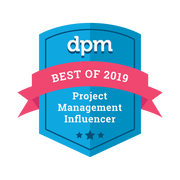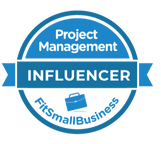Stephen Carver is a university lecturer at Cranfield School of Management and also spends much of his time consulting directly with corporations. Because of his ability to bridge the gap between academia and the world of project management practitioners, his insights are well worth listening to.
The three types of complexity
When Cranfield began to research the topic they identified over 40 different types of complexity. These types were reduced down to three major buckets, which made it easier for ordinary people to use and relate to.
1. Blue bucket – structural complexity. This type of complexity is related to traditional ways of assessing a project in terms of size and scope: I.e. how technically complex is the project, how much work needs to get done, how many people are involved, how many sub-contractors need to be engaged and across how many locations? In other words, structural complexity is a measure of how many moving parts there are on your project.
A good example of structurally complex projects would be construction projects. They have a high level of technical complexity and many moving parts that make them challenging to manage, not least logistically. To reduce structural complexity we can use traditional project management tools such as breakdown structures, critical path analysis and risk management.
2. Green bucket – emergent complexity. This type of complexity is all about change. How much is your project and its surroundings changing as you are trying to manage it? Are world events or the price of oil or exchange rates impacting your project? Is the client or the team constantly changing or new stakeholders emerging? We already know that change is inevitable on projects, but some projects are more subjected to change than others. If you’re working on a highly innovative project or a project that is dependent on external world events, the emergent complexity will be high.
The trick in dealing with this type of complexity is to see change as an opportunity rather than a treat. On most projects we tend to see change as a bad thing. We want to control it and mitigate all risks up front with our risk registers. But that approach doesn’t fully work with this type of complexity. The rate of change is simply too high for us to effectively be able to control it. Instead we have to change our mind-set and see change as an opportunity rather than a threat. Change can be good if we open our minds to it and become more agile in our approaches.
3. Red bucket – socio political complexity. This type of complexity is about soft skills, relationships, personalities and behaviours that arise under stress. It’s the touchy feely stuff as Stephen Carver calls it. And it’s this “soft” stuff that’s really the hard part and the area that most project managers and engineers struggle with. It’s not obvious how to manage a bunch of clients and stakeholders who change their minds and who behave in infinitely complex ways, especially under pressure.
Carver uses the example of an office move. Structurally it’s an easy project to deliver without too many moving parts, but it scores highly on the socio political spectrum. People will fight over who gets the corner office and the nice view. They will act irrationally because they feel uncertain and fearful about the move at a psychological level. To effectively handle the situation project managers need to be trained in how to build trust and deepen personal relationships. They need to learn to listen and empathise and to use different styles of communication.
Most project issues stem from socio political complexity
At Cranfield School of Management the academics asked about 250 project management practitioners which of the three types of complexity caused them most trouble on live projects. 70% of respondents said that it was the socio political factors that caused them the most problems. 20% answered that their issues predominantly stemmed from emergent complexity. Only 10% said their issues were due to structural complexity.
The researches then asked people which of the three categories of complexity had received the most attention during their formal training. It turned out that 80% of the training and certification was focused on structural complexity, 10% on emergent and 10% on socio political complexity. In other words, although most project issues stem from socio political complexity, project managers and engineers are predominantly trained to tackle structural complexity.
Process isn’t the answer
When we look at the five levels of competency for project management in an organisation, it turns out that implementing a structured approach to managing projects will help an organisation progress to level three out of five. Beyond this level however, the organisation needs more than structure and processes. It needs to master socio political and emergent complexity to get to level four and beyond.
Level 2 – At the 2nd level of maturity, a small part of the organisation understands change management – typically the IT department. As a result organisational-wide projects are executed far from smoothly and the vast majority of projects are failing. They may have invested in some really good IT systems, but they are not fully integrated or adopted across the organisation.
Level 3 – At this level the CEO understands that everyone needs a common methodology. PRINCE2 or a similar framework is rolled out across the organisation, which gives teams a common language. Many projects still go wrong, but at least the organisation has an audit trail and will carry out post mortems.
Level 4 – At this level people across the organisation buy into project management methodologies and the majority of projects are executed successfully. Getting to level four however isn’t as a result of implementing more process. On the contrary! More process can make the organisation go backwards. At this level it’s about mastering the socio political aspects and the soft stuff. The same is true for level five.
Level 5 – At the highest level of maturity, project change is the order of the day. The organisation gets it and running projects is an integrated part of their strategy. Not only is structural complexity addressed, they are also on top of socio political and emergent complexity. The organisation is agile and sees change as an opportunity.
Conclusion
Stephen Carver stresses that the researches have now proven what we already knew intuitively. Process is necessary, but it certainly isn’t sufficient to master project delivery. The message isn’t to throw away our processes, but to enrich our approach with an ability to effectively deal with irrational behaviours and large amounts of change in relation to our projects.
If you liked this post, you may also like:
Project Leadership - 20 essential tips
Why do projects continue to fail - and what can we do about it?
What are the differences between management and leadership?
Are you bridging the gap between vision and delivery?
The secret to authentic leadership in projects









 RSS Feed
RSS Feed